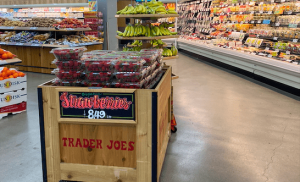The Location Selection Process of Trader Joe’s
Have you ever wondered how Trader Joe’s decides where to open up new stores? The location selection process of Trader Joe’s is a captivating endeavor that involves thorough research, careful analysis, and a deep understanding of their target market. By considering factors such as demographics, proximity to potential customers, and the availability of suitable real estate, Trader Joe’s ensures that their stores are conveniently located and strategically positioned to serve their loyal customer base. In this article, we will explore the fascinating journey behind the location selection process of Trader Joe’s, shedding light on the meticulous thought and effort that goes into bringing their unique grocery shopping experience to communities across the country.
Overview of Trader Joe’s
Trader Joe’s is a beloved grocery store chain that has gained a loyal following for its unique offerings, affordable prices, and friendly atmosphere. With its quirky and fun approach to grocery shopping, Trader Joe’s has become a go-to destination for many consumers seeking a different shopping experience. This article aims to provide a comprehensive understanding of how Trader Joe’s selects its store locations, examining the factors influencing location selection and the company’s expansion strategy.
History of Trader Joe’s
Before delving into the location selection process, it is important to understand the history of Trader Joe’s. The chain was founded in 1958 by Joe Coulombe as a convenience store in Pasadena, California. Over the years, it evolved into a specialty grocery store, catering to food enthusiasts looking for unique and high-quality products. In 1979, the chain was acquired by German grocery retailer Aldi Nord, which propelled its growth and national expansion. Today, Trader Joe’s has over 500 stores across the United States, making it an integral part of the American grocery landscape.
Unique features of Trader Joe’s
One of the standout features of Trader Joe’s is its carefully curated selection of private-label products. The store offers a wide array of innovative and affordable items that can’t be found elsewhere, from gourmet snacks and exotic spices to organic produce and vegan options. Trader Joe’s also prides itself on creating a welcoming and enjoyable shopping environment, with friendly and knowledgeable staff who are always ready to assist customers. The store’s visually appealing displays and sampling stations contribute to the overall delightful experience that keeps shoppers coming back for more.
Expansion strategy of Trader Joe’s
Trader Joe’s takes a methodical approach to its expansion strategy, carefully analyzing various factors to determine the most suitable locations for new stores. The company’s goal is to provide convenience to its target demographic while maintaining the uniqueness and affordability that it is known for. By strategically selecting store locations, Trader Joe’s aims to reach a wider audience and make its products accessible to more customers. The next sections will delve into the factors that influence Trader Joe’s location selection process, offering insights into the company’s decision-making process.
Factors Influencing Location Selection
Several factors are taken into consideration when Trader Joe’s evaluates potential locations for its new stores. These factors are essential in determining the viability and success of each location. By conducting a thorough analysis, Trader Joe’s can ensure that its stores are positioned in areas where they will thrive and cater to the needs of their customers. The key factors influencing Trader Joe’s location selection process are demographic analysis, traffic patterns, competition analysis, availability of real estate, proximity to suppliers, customer preferences, economic indicators, and legal and regulatory considerations.
Demographic analysis
Trader Joe’s pays significant attention to demographic analysis as it plays a crucial role in understanding the target market and identifying locations with the potential for success. By examining factors such as population density, income levels, education, and occupation, Trader Joe’s can gain insights into the purchasing power and preferences of the local residents. This information guides the company in selecting locations where its unique and affordable products will resonate with the target demographic.
Traffic patterns
Another important factor in determining location feasibility is analyzing traffic patterns. Trader Joe’s aims to be easily accessible to its customers, so accessibility to major roads and highways, as well as proximity to public transportation, are carefully considered. Additionally, parking facilities are evaluated to ensure that customers have a convenient shopping experience without the hassle of finding a parking spot. By situating stores in areas with favorable traffic patterns, Trader Joe’s can attract and retain a steady flow of customers.
Competition analysis
Understanding the local grocery landscape and evaluating the competition is an integral part of Trader Joe’s location selection process. The company assesses the presence of local grocery stores, supermarkets, specialty food stores, health food stores, and even online grocery delivery services in the target area. This analysis helps Trader Joe’s identify gaps in the market and determine if there is an opportunity to offer something unique and different from existing competitors. By carving out its own niche, Trader Joe’s can establish itself as a preferred shopping destination for customers seeking alternative options.
Availability of real estate
Securing suitable real estate is critical for the success of any retailer, and Trader Joe’s is no exception. The location scouting process involves evaluating potential sites for lease or purchase. Trader Joe’s considers various factors such as the size and condition of the property, its visibility, and its compatibility with the overall Trader Joe’s brand and image. Additionally, the company looks for opportunities for future expansion to accommodate its growth plans.
Proximity to suppliers
Trader Joe’s prides itself on its efficient supply chain management and commitment to offering high-quality products. Proximity to suppliers is a crucial factor in maintaining freshness and ensuring timely deliveries. Trader Joe’s evaluates potential store locations in relation to its network of suppliers, aiming to establish stores in areas that allow for efficient distribution and minimize transportation costs. By selecting locations close to reliable suppliers, Trader Joe’s can consistently provide customers with fresh and high-quality products.
Customer preferences
Understanding customer preferences is essential for any business, and Trader Joe’s is no exception. The company conducts extensive market research, surveys, and analysis to gauge customer demand, determine product popularity, and identify emerging trends. Additionally, Trader Joe’s encourages feedback and reviews from customers, taking into account their preferences and suggestions. By staying attuned to customer preferences, Trader Joe’s can adapt its product offerings and ensure that its stores are tailored to the needs and desires of its customers.
Economic indicators
Trader Joe’s also considers economic indicators as part of its location selection process. Factors such as local economic growth, unemployment rates, disposable income levels, and consumer spending patterns are carefully analyzed. These indicators provide valuable insights into the financial health of a potential location and its residents’ purchasing power. By situating stores in areas with a favorable economic climate, Trader Joe’s can increase its chances of success and capitalize on the disposable income of its target demographic.
Legal and regulatory considerations
Lastly, Trader Joe’s takes into account legal and regulatory considerations when selecting store locations. The company ensures compliance with local zoning and licensing regulations, as well as any other relevant legal requirements. By adhering to the applicable laws and regulations, Trader Joe’s can avoid unnecessary complications and smoothly integrate into the local community.
Demographic Analysis
Understanding the target demographic is a crucial element of Trader Joe’s location selection process. By analyzing various demographic factors, Trader Joe’s can identify areas where its unique offerings will resonate with the local population and drive sales.
Target demographic of Trader Joe’s
Trader Joe’s caters to a diverse range of customers, but its target demographic typically consists of individuals and families who appreciate quality, affordability, and an enjoyable shopping experience. These customers are often health-conscious, trend-savvy, and open to trying new and innovative food products. Trader Joe’s aims to create a sense of community and cater to the preferences of its target demographic through its unique product offerings and friendly atmosphere.
Population density
Population density is a crucial factor that Trader Joe’s considers when selecting store locations. The company looks for areas with a sufficient population to support a store, ensuring a ready customer base. Typically, locations with higher population densities are preferred, as they provide a larger pool of potential customers and a higher likelihood of success.
Income levels
Income levels are another important consideration for Trader Joe’s. The company seeks locations where the local residents have sufficient disposable income to afford its unique offerings. Trader Joe’s aims to strike a balance between affordability and quality, ensuring that its products are accessible to a wide range of income levels. Areas with higher median incomes are often prioritized, as they generally indicate a greater potential for sales.
Education and occupation
Analyzing the education and occupation demographics of an area is valuable for Trader Joe’s. The company looks for locations where the residents have a higher level of education, as they are more likely to appreciate the unique products and value proposition that Trader Joe’s offers. Additionally, areas with a diverse range of occupations provide opportunities for targeting specific customer segments and tailoring the store’s product offerings accordingly.
Traffic Patterns
Easy accessibility is a key factor in Trader Joe’s location selection process. The ability for customers to conveniently reach the store plays a significant role in its success.
Access to major roads and highways
Trader Joe’s seeks locations with easy access to major roads and highways. This ensures that customers can easily reach the store without facing excessive travel times or complicated routes. Proximity to major transportation arteries also facilitates efficient product deliveries, minimizing transportation costs and ensuring a steady supply chain.
Proximity to public transportation
Trader Joe’s also takes into consideration the proximity to public transportation when selecting store locations. By situating stores near bus stops, subway stations, or other public transportation hubs, the company ensures that customers who rely on public transportation can conveniently visit the store. This consideration enables Trader Joe’s to serve a broader customer base and make its products accessible to those without private vehicles.
Parking facilities
Providing ample and convenient parking facilities is a priority for Trader Joe’s. The company understands that customers appreciate the convenience of parking near the store entrance. When selecting store locations, Trader Joe’s evaluates the availability of parking spaces to ensure that customers can have a hassle-free shopping experience. Ample parking facilities also contribute to the overall accessibility and attractiveness of a location, making it more likely for customers to choose Trader Joe’s over competitors.
Competition Analysis
Trader Joe’s conducts thorough competition analysis to understand the grocery landscape and position itself uniquely within the market.
Local grocery stores and supermarkets
Trader Joe’s carefully evaluates the presence of local grocery stores and supermarkets in potential locations. The company seeks to identify gaps in the market and avoid direct competition with established players. By offering unique and differentiated products, Trader Joe’s can carve out its own niche within the local grocery landscape and attract customers who are looking for something different.
Specialty food stores
Trader Joe’s also considers the presence of specialty food stores in the area. These stores often cater to specific customer segments with their curated selection of products. Trader Joe’s looks for opportunities to complement the offerings of specialty food stores by providing a wider range of unique and affordable options. This approach allows Trader Joe’s to attract customers who appreciate specialty and gourmet food items without compromising on affordability.
Health food stores
Given the increased interest in health-conscious products, Trader Joe’s evaluates the presence of health food stores in potential locations. The company aims to provide customers with healthy and organic options at affordable prices. By positioning itself as an alternative to traditional health food stores, Trader Joe’s can attract customers who prioritize their well-being without burning a hole in their pockets.
Online grocery delivery services
Trader Joe’s considers the competition posed by online grocery delivery services. With the growing popularity of e-commerce, it is important for Trader Joe’s to assess the convenience and accessibility offered by online platforms. While physical stores remain the core focus for Trader Joe’s, the company may consider partnering with or exploring its own online delivery options to cater to customers who prefer the convenience of shopping from the comfort of their homes.
Availability of Real Estate
Securing suitable real estate is a crucial aspect of Trader Joe’s location selection process. The company follows a meticulous approach to identify and evaluate potential sites.
Location scouting
Trader Joe’s employs expert teams to conduct extensive location scouting. These teams analyze various factors, such as the surrounding neighborhood, customer demographics, and accessibility. By conducting on-the-ground research, Trader Joe’s gains valuable insights into the suitability of different locations and their potential for success.
Lease negotiations
Once potential locations are identified, Trader Joe’s engages in lease negotiations. The company ensures that lease agreements align with its long-term goals and financial considerations. Trader Joe’s aims to negotiate lease terms that are favorable, allowing the company to maintain its unique offerings at affordable prices, while also securing space for future expansion.
Property size and condition
Trader Joe’s assesses the size and condition of potential properties during the location selection process. The company aims to secure properties that are adequate in size to accommodate its range of products and provide a comfortable shopping experience for customers. Additionally, properties in good condition require less investment in renovations and improvements, contributing to cost-effective operations.
Expansion opportunities
Trader Joe’s also considers the potential for expansion when selecting store locations. The company seeks properties that have the potential for growth, enabling it to meet increased customer demand in the future. By strategically selecting locations with expansion opportunities, Trader Joe’s can ensure its long-term viability and continuous growth.
Proximity to Suppliers
Trader Joe’s prioritizes proximity to its suppliers to maintain efficient supply chain management and ensure the freshness and quality of its products.
Efficient supply chain management
By selecting store locations in close proximity to suppliers, Trader Joe’s can reduce transportation costs and minimize logistical challenges. Efficient supply chain management enables the company to keep its shelves stocked with fresh items consistently. This approach ensures that customers have access to a wide variety of high-quality products, reinforcing the reputation and trustworthiness of the Trader Joe’s brand.
Freshness and quality of products
Trader Joe’s prides itself on offering fresh and high-quality products to its customers at affordable prices. By selecting store locations that allow for quick and easy transportation of goods from suppliers, Trader Joe’s can ensure that its products maintain their freshness and quality. The company’s commitment to providing customers with the best possible shopping experience is reflected in its emphasis on proximity to suppliers.
Sustainability and eco-friendly practices
In line with its commitment to sustainability, Trader Joe’s considers the environmental impact of its supply chain. By selecting suppliers located near its store locations, the company can reduce carbon emissions associated with transportation. Additionally, a shorter supply chain enables Trader Joe’s to support local and regional suppliers, fostering a more sustainable and eco-friendly approach to grocery retail.
Customer Preferences
Trader Joe’s places a strong emphasis on understanding customer preferences to tailor its stores to the needs and desires of its target demographic.
Market research and surveys
Trader Joe’s regularly conducts market research and surveys to gather insights into customer preferences and trends. This information plays a crucial role in determining the product offerings and overall customer experience at each store location. By staying attuned to evolving customer preferences, Trader Joe’s can adapt and adjust its offerings to remain relevant and appealing to its target demographic.
Product demand and popularity
Trader Joe’s closely monitors the demand for various products and keeps a keen eye on their popularity. The company evaluates sales data and customer feedback to determine which products are the most sought-after and which have the greatest potential for success. This information guides the product selection process and helps Trader Joe’s curate a unique and enticing assortment of offerings.
Feedback and reviews
Trader Joe’s actively seeks customer feedback and encourages reviews to gain insights into customers’ experiences and preferences. The company values the opinions of its customers and uses their feedback to improve its offerings and address any areas for improvement. By listening to its customers, Trader Joe’s can enhance the customer experience and strengthen its connection with its loyal fan base.
Trends and preferences
Staying on top of emerging trends and preferences is essential in the retail industry. Trader Joe’s monitors shifts in consumer behavior, dietary preferences, and culinary trends to anticipate changing customer needs. By incorporating popular trends and unique offerings, Trader Joe’s can retain its status as an innovative and forward-thinking grocery store, constantly surprising and delighting its customers.

Economic Indicators
Trader Joe’s analyzes various economic indicators to gauge the financial health and potential success of a location.
Local economic growth
Trader Joe’s evaluates the local economic growth of potential locations to assess their viability. A growing economy indicates increased employment opportunities and disposable income levels, which can positively impact customer spending habits. Trader Joe’s aims to position its stores in areas with a thriving economy, where residents have the financial capacity to appreciate the unique offerings and affordability that the store provides.
Unemployment rates
Unemployment rates play a significant role in determining the purchasing power of potential customers. Trader Joe’s considers the unemployment rates of potential locations to understand the economic stability of the area. Lower unemployment rates generally indicate a financially secure customer base, which bodes well for the success of Trader Joe’s stores.
Disposable income levels
The disposable income levels of local residents are a crucial economic indicator analyzed by Trader Joe’s. The company seeks locations where residents have disposable income to afford its unique offerings. By selecting areas with higher disposable income levels, Trader Joe’s can position itself as an attractive shopping destination for economically empowered customers.
Consumer spending patterns
Analyzing consumer spending patterns provides insights into the buying habits and preferences of potential customers. Trader Joe’s closely examines consumer spending data to understand how individuals allocate their budgets and assess whether there is room for its unique and affordable products. By identifying areas where consumer spending patterns align with the Trader Joe’s value proposition, the company can strategically position its stores and increase the likelihood of success.
Community Engagement and Social Responsibility
Trader Joe’s places a strong emphasis on community engagement and social responsibility, aligning its stores with local organizations and demonstrating sustainability initiatives.
Engagement with local organizations
Trader Joe’s actively seeks to engage with local organizations to foster a sense of community and support local initiatives. This involvement may include partnerships with food banks, donations to nonprofits, or participation in community events. By engaging with local organizations, Trader Joe’s demonstrates its commitment to the communities it serves and builds strong relationships with customers on a local level.
Sustainability initiatives
Trader Joe’s prioritizes sustainability and incorporates eco-friendly practices into its operations. The company makes conscious efforts to reduce waste and energy consumption, implement recycling programs, and source products from sustainable suppliers. By demonstrating a commitment to sustainability, Trader Joe’s resonates with environmentally conscious customers and builds a reputation as an environmentally responsible retailer.
Philanthropy and community support
Philanthropy and community support are integral to Trader Joe’s corporate philosophy. The company actively supports local charities and community initiatives through donations, sponsorships, and volunteer efforts. Trader Joe’s aims to make a positive impact on the communities it operates in and create a sense of giving back. By aligning itself with charitable causes, Trader Joe’s cultivates a strong sense of loyalty and goodwill among its customers.
In conclusion, Trader Joe’s takes a comprehensive and meticulous approach to select store locations. By analyzing various factors such as demographic data, traffic patterns, competition, real estate availability, supplier proximity, customer preferences, economic indicators, and legal considerations, Trader Joe’s ensures that its stores are strategically positioned to serve its unique and diverse customer base. Additionally, the company actively engages with local communities and supports social responsibility initiatives, further enhancing its reputation as a beloved and responsible grocery store chain.













